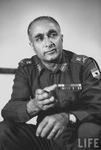Nickname(s) Bijji Rank Lieutenant General Died April 18, 1972, New Delhi | Years of service 1932-1962 Name Brij Kaul | |
 | ||
Born May 1, 1912 ( 1912-05-01 ) Education Royal Military Academy Sandhurst Books Confrontation with Pakistan Similar People Jawaharlal Nehru, Pran Nath Thapar, V K Krishna Menon, Zhang Guohua, Zhou Enlai | ||
Brijmohan Kaul was a Lieut General and the Chief of General Staff (CoGS) in the Indian Army. He resigned in the aftermath of the 1962 Sino-Indian War. He was responsible for raising and expanding Jammu and Kashmir militia which later entered Indian Army as Jammu and Kashmir Light Infantry, and was awarded the Param Vishisht Seva Medal in 1960.
Contents

Personal life
He was born in 1912 on Buddha Jayanti to Gaura and Jagmohan Kaul in Lahore. He had a sister (Dulari), and a half-brother (Shyam) and a half-sister (Nanni). He married Dhanraj Kishori; they had two daughters Anuradha and Chitralekha.
Career
After attending the Royal Military College, Sandhurst he was commissioned a Second Lieutenant on the Unattached List for the Indian Army on the 31 August 1933. He then spent the next year attached to a British Army regiment in India, the 1st battalion the East Surrey Regiment, starting 5 November 1933. After his years attachment accepted for the Indian Army and he was posted to the 5th Battalion, 6th Rajputana Rifles on 10 November 1934 with his date of commission as a Second Lieutenant antedated to 2 February 1933. He was promoted to Lieutenant 2 May 1935 but by mid-1936 he was attached away from the battalion to the Royal Indian Army Service Corps, a posting that led to a permanent transfer on 18 February 1937.
At the outbreak of World War Two he was serving with the 26th Mechanical Transport Company. He was promoted Captain 2 February 1941, acting Major 7 November 1942 and local Lieutenant-Colonel 14 December 1942, War Substantive Major & temporary Lieutenant Colonel 19 February 1944 and Major 1 July 1946. He was promoted a Colonel in late 1947 and swiftly promoted to Brigadier in 1950.
In October–December 1946, he was the secretary to "Armed forces nationalisation committee" constituted by Viceroy. Coincidentally, it was led by N Gopalawami Ayengar, later defense minister, with members including future Chief of Army Staff General Thimayya, future Pakistan Army chief Muhammad Musa and future Indian MP H.N. Kunzru. The General Officer was well known in the Army and Political Circles to be a "personal favourite" of Jawaharlal Nehru since his junior officer days. He reportedly received a number of undue professional favours throughout his career due to this personal connection and he made full use of this opportunity with utter disregard to the Army organisation. He managed to keep himself away from hardship and learning the nuances of a military commander as a junior officer and later in service, managed to grab important Army senior command appointments due to his "pull". His involvement with Jawaharlal Nehru later turned out to be a major reason for shameful loss and massacre of Indian troops at the hands of the Chinese.
In 1947, Kaul was a defence attache in Washington. He returned to India in the aftermath of Indian Pakistan hostilities over Kashmir.
In 1962, he was appointed as the commander of IV Corps in the north eastern region of India.
Operation leghorn
In 1962, the then Chief of General Staff (CGS) of Indian Army, Lt General B.M. Kaul was appointed as the General officer Commanding (GOC) the North east, replacing Lt General Umrao Singh. Kaul was to head the newly appointed IV Corps at Tezpur, however no new troops were sent to the corps with only the new headquarter staff being deployed there. The entire NEFA (North East Frontier Agency), now Arunachal Pradesh was made Kaul's domain.
On his first day of assignment, Kaul flew to Lumpu & then trekked to Namkachu valley. He was the first General officer to visit the valley. Under his leadership, the Indian patrol occupied Tse Jong, a hillock north-west of the Chinese settlement. Kaul reportedly fell ill during the assignment and was deported to New Delhi. The Indian patrol occupying Tse Jong was wiped out when an 800 strong enemy force raided the post subsequently.
The battle with China in 1962, in the NEFA, is also known as the Battle of Namkachu.
Param Vishisht Seva Medal
He was also the first ever recipient of the Param Vishisht Seva Medal instituted by the Indian government in 1960.
His citation reads : For successfully completing the project 'Amar' which entailed the construction of 1,450 quarters for troops in Ambala. This was the first project of its kind and was completed through hot weather and the monsoons in the face of numerous problems. Lt.-Gen. Kaul overcame these difficulties by dint of hard work and initiative of the highest order. He displayed organising ability, drive, and resourcefulness. It was by his determination, leadership and personal example that the task was completed by due date.
Books Authored
He wrote his side of the story about operation leghorn in the book The Untold Story and, in another book, Confrontation with Pakistan.
